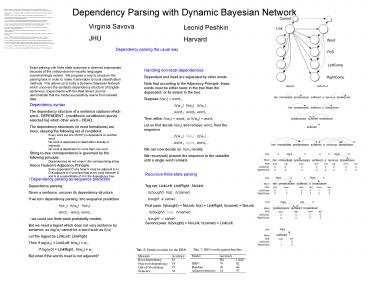Dependency Parsing with Dynamic Bayesian Network PowerPoint PPT Presentation
1 / 1
Title: Dependency Parsing with Dynamic Bayesian Network
1
Dependency Parsing with Dynamic Bayesian Network
Bilmes, J. and Zweig, G. (2002). The graphical
models toolkit An open source software system
for speech and time-series processing. IEEE Int.
Conf. on Acoustics, Speech, and Signal
Processing, June 2002. Orlando Florida. Frank,
R., Mathis, D., and Badecker, W. (2005). The
acquisition of anaphora by simple recurrent
networks. Unpublished manuscript. Kersten, D. and
Yuille, A. (2003). Bayesian models of object
perception. Cognitive Neuroscience,
1319. Klein, D. and Manning, C. (2004).
Corpus-based induction of syntactic structure
Models of dependency and constituency. In
Proceedings of the 42nd Annual Meeting of the
ACL. Knill, D. C. and Richards, W., editors
(1996). Perception as Bayesian inference.
Cambridge University Press. Kording, K. and
Wolpert, D. (2004). Bayesian integration in
sensorimotor learning. Nature, 427244247. Lives
cu, K., Glass, J., and Bilmes, J. (2003). Hidden
featuremodels for speech recognition using
dynamic bayesian networks. In 8th European
Conference on Speech Communication and Technology
(Eurospeech). Marcus, M., Santorini, B., and
Marcinkiewicz, M. A. (1993). Building a large
annotated corpus of english the penn treebank.
Computational Linguistics, 19. Murphy, K.
(2002). Dynamic Bayesian Networks
Representation, Inference and Learning. PhD
thesis, Univ. of California at Berkeley. Peshkin,
L., Pfeffer, A., and Savova, V. (2003). Bayesian
nets for syntactic categorization of novel words.
In Proceedings of the NAACL. Rao, R. P. N.
(2005). Hierarchical bayesian inference in
networks of spiking neurons. In Saul, L. K.,
Weiss, Y., and Bottou, L., editors, Advances in
Neural Information Processing Systems 17. MIT
Press, Cambridge, MA. Shieber, S. (1985).
Evidence against the context-freeness of natural
language. Linguistics and Philosophy,
8333343. Stocker, A. and Simoncelli, E.
(2005). Constraining a bayesian model of human
visual speed perception. In Saul, L. K., Weiss,
Y., and Bottou, L., editors, Advances in Neural
Information Processing Systems 17. MIT Press,
Cambridge, MA. Yu, A. J. and Dayan, P. (2005).
Inference, attention, and decision in a bayesian
neural architecture. In Saul, L. K., Weiss, Y.,
and Bottou, L., editors, Advances in Neural
Information Processing Systems 17. MIT Press,
Cambridge, MA.
Virginia Savova JHU
Leonid Peshkin Harvard
Dependency parsing the usual way
Exact parsing with finite state automata is
deemed inapropriate because of the unbounded
non-locality languages overwhelmingly exhibit.
We propose a way to structure the parsing task in
order to make it amenable to local classification
methods. This allows us to build a Dynamic
Bayesian Network which uncovers the syntactic
dependency structure of English sentences.
Experiments with the Wall Street Journal
demonstrate that the model successfully learns
from labeled data.
Handling non-local dependencies Dependent and
head are separated by other words Note that
according to the Adjacency Principle, these words
must be either lower in the tree than the
dependent, or its sisters in the tree. Suppose
h(w1) word-1 ...h(w-1) h(w0)
h(w1)... ...word-1 word0 word1... Then either
h(w0) word-1 or h(w0) word1 Let us first
decide h(w0) and remove word0 from the sequence
...h(w-1) h(w0) h(w1)... ...word-1 word0
word1... We can now decide on h(w1) locally. We
recursively present the sequence to the
classifier until a single word remains.
Dependency syntax The dependency structure of a
sentence captures which word - DEPENDENT -
modifies/is conditioned upon/is selected by
which other word HEAD. The dependency
structures (in most formalisms) are trees,
obeying the following set of conditions Every
word but one (ROOT) is dependent on another word.
No word is dependent on itself either directly
or indirectly. No word is dependent on more than
one word. String-to-tree correspondence is
governed by the following principle Dependencies
do not cross in the corresponding string. Hence
Hudsons Adjacency Principle Every dependent D
of a head H must be adjacent to H. D is adjacent
to H provided that every word between D and H is
a subordinate of H in the dependency tree.
Recursive finite-state parsing Tag set
LinkLeft, LinkRight, NoLink ...h(bought) h(a)
h(camel)... ...bought a camel... First pass
h(bought) NoLink h(a) LinkRight h(camel)
NoLink ...h(bought) h(a) h(camel)... ...bought
a camel... Second pass h(bought) NoLink
h(camel) LinkLeft
! Dependency parsing as sequence
prediction Dependency parsing Given a sentence,
uncover its dependency structure. If we turn
dependency parsing into sequence
prediction ...h(w-1) h(w0) h(w1)... ...word-1
word0 word1... ...we could use finite-state
probability models. But we need a tagset which
does not vary sentence by sentence, so tag(w)
cannot be a word such as h(w). Let the tagset be
LinkLeft, LinkRight Then if tag(w0) LinkLeft,
h(w0) w-1 if tag(w0) LinkRight,
h(w0) w1 But what if the words head is not
adjacent?

